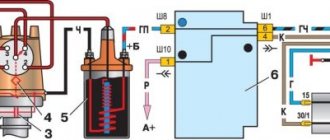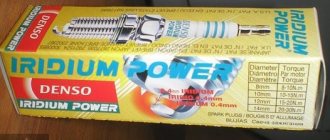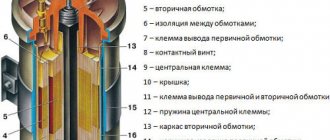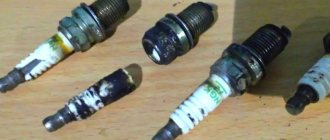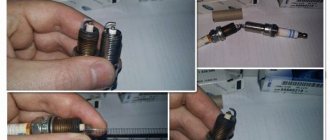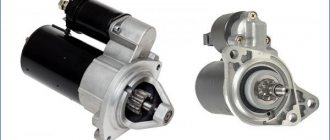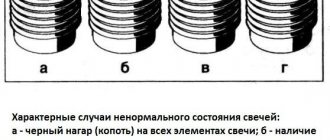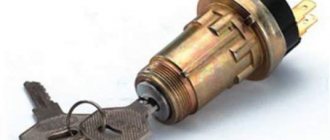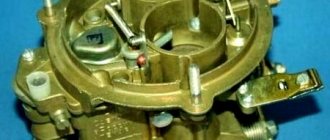What to do?
Based on the advice of experienced car enthusiasts, we suggest checking the possible causes of the malfunction. First of all, use a spark gap to know where exactly the spark disappears. If the cylinders are faulty, pay attention to the controller, the module as a whole, or the coil.
Start with a visual inspection of the high-voltage wire (the ideal is good external condition with intact insulation). Repair or replace the element as necessary.
If the problem is not found, we go directly to the SZ. Clean or replace rusty contacts if necessary. Before making a decision, test the presence of a discharge on the spark plugs: bring the wire 0.5 cm to the metal and spin the starter. A blue-white spark signals normality. Another color (purple, for example) - go to the coil (KZ).
The operation of the coil is tested in the same way as the discharge on spark plugs (see above). Two scenarios:
- sparked - see distributor-breaker (R/P);
- did not “ignite” (deal with the coil).
In the R/P it is necessary to exclude oxidation, insulation failure and test the rotor. Inspect the inside of the cover to ensure there are no cracks. Check the carbon contact with your hand to see if it is stuck. Insulation check:
- place the central high-voltage wire 0.8 cm from the electrode;
- connect and disconnect the contact (turn on the ignition first).
If the rotor is faulty, sparks are visible.
In a short circuit, exclude damage to the winding and short circuit (burnt points).
The low voltage circuit is tested with a twelve-volt light bulb with a power of no more than 3 W. It is connected to the breaker and the hardware of the car. Next, close the R/P and turn on the ignition. If the circuit is working properly, the standard lights up when it opens and goes out when it closes. “Controller” does not go out under the following circumstances:
- corrosion in connecting parts;
- the connection to the drive lever is broken;
- The connection between the case and the disk is broken.
Test the candles one at a time, as they practically do not break at the same time. Disconnect the element, attach a wire to it and touch the metal of the element to ground. Turn on the starter.
Spark boost
To increase the spark on the candles you need:
- copper high voltage wires,
- a set of keys,
- spark booster,
- kit for installing contactless ignition.
Most modern spark plugs use special resistors, which should reduce electromagnetic field interference. If you install spark plugs without resistors, the amount of released energy will increase by 50%. Replace all high-voltage wires with copper ones. By reducing the system resistance, the energy at the spark plugs will increase. Increase the interelectrode distance and test the spark plug in a special pressure chamber. Select the longest interval at which a stable spark is observed at a pressure of 10 kg/cm². In this case, the duration of the spark remains the same as it was, but its energy, and therefore power, increases. But this increases the load on high-voltage wires, so their quality must be high. This will increase the spark energy by approximately one and a half to two times.
To increase energy, a special spark amplifier is used, which is mounted directly on the spark plug. This device consists of a capacitor and two connections, one of which is attached to the spark plug, the other to the high-voltage wire. During operation of the device, there is some delay in the discharge of the spark plug due to the charging of the capacitor. In this case, the amplitude of the current increases significantly, and with it the temperature of the spark during discharge.
If your car has a contact (currently outdated) ignition system, replace it with a contactless one. Purchase a standard kit consisting of a high voltage coil, a Hall sensor, a switch and a set of wires. Install a high-voltage coil under the hood, replace the “slider” with a Hall sensor, and install high-voltage wires. Pay attention to the ignition timing marks on the crankshaft. Replace the spark plugs with new ones and connect all the elements with wires according to the diagram. Set the ignition timing.
Best Sports Car 2011 Ferrari Italia 458
A device for increasing the plasma volume of a spark in a spark plug relates to the field of engine engineering, in particular to spark methods for igniting the fuel mixture. The device contains a series LC circuit formed by a capacitor and an inductor and connected directly in parallel to the spark gap of the spark plug. The natural frequency of the LC circuit lies in the range from 1 to 5 MHz and the parameters of the circuit are selected such that when it is closed through a broken spark gap, damped oscillations in it maintain the spark burning for a time of the order of 2-3 s. The high-voltage wire from the ignition system is connected to the connection point between the spark plug and the LC circuit through a damping choke. The device serves to increase the plasma sheath around the spark streamer without significantly increasing the discharge energy. 1 salary f-ly, 2 ill.
The invention relates to the field of engine building, in particular to spark methods for igniting the fuel mixture. The closest analogues of the proposed device may be the system proposed in the author's certificate and the domestic ignition system "Electronics 3M-K". The scheme described in has a number of significant disadvantages. Manufacturing a magnetic storage device on a rectangular magnetic core is a complex technical task (several tens of turns of coaxial cable withstanding 20 kV). The dimensions of such a device will be very large. In addition, the accumulation of energy and its concentration for 10-100 ns at the moment of spark formation leads to a sharp increase in erosion of the spark plug electrodes. Ignition systems like the domestic “Electronics 3M-K” or “Iskra-5” use a multi-spark mode of ignition of the fuel mixture. However, due to the high leakage inductance of the ignition coil, the interval between high voltage pulses is difficult to make less than 0.5 ms, i.e. sparks following the first will affect the fuel mixture at a non-optimal point in time (top dead center). Based on the foregoing, it is clear that simultaneous improvement of fuel ignition conditions and a decrease in the degree of detonation at the moment of ignition, as well as a decrease in erosion of the spark plug electrodes requires a fundamental change in the physical parameters of the spark. It is necessary to increase the volume of the plasma sheath around the spark streamer, and it is advisable to do this without significantly increasing the discharge energy. The German patent of 1962 was chosen as a prototype. In this patent, a three-link L-shaped LC circuit is connected parallel to the high-voltage winding of the ignition coil, acting as a storage element. When a spark channel is formed, the energy accumulated on the capacitors is released into the spark. Since the frequency spectrum in this circuit lies below 100 kHz, and the lifetime of the streamer in the spark does not exceed 500 ns, we have a regime close to multiple sparking. Although the parameters of such a spark are close to optimal, the technical implementation of this device encounters a number of difficulties. Firstly, even on a modern element base, inductance and capacitance of such ratings as given in the patent, for a voltage of 20-50 kV, will be very large. Secondly, in modern ignition systems, high-voltage wires connecting the ignition coil to the distributor and the distributor to the spark plug have a resistance of 3-8 kOhm. This makes the proposed system ineffective, because resistance, damping the LC circuit, leads to rapid attenuation of oscillations. The resistance of the spark channel is approximately 20 Ohms, i.e. The energy stored in capacitors is dissipated mainly in the wires. To circumvent all these difficulties, a serial LC circuit is placed in the circuit directly next to the spark plug, thereby eliminating the influence of high-resistance wires. The proposed device is shown in Fig. 1. Here the short circuit is the ignition coil, P r is a high-resistance (1-5 kOhm) wire, P is the distributor, C 1 and C 2 are spark plugs. The inductance L is a coil of 30 turns. The core of the coil is a rod made of radioferrite brand M400 or M600, with a diameter of 8-10 mm and a length of about 45 mm. A gap of at least 1 mm is required between the ferrite and the winding. This design provides high inductance and quality factor at currents up to 100 A, voltage pulses of 10-12 kV, in the frequency range up to 5 MHz. Since the cooling time of the plasma channel in the spark does not exceed 500 ns, for the continuous combustion mode it is necessary that the natural frequency of the LC circuit be above 1 MHz. With the proposed design of the inductance, the capacitance C is of the order of 100-500 pF. With this capacitance rating, the LC circuit turns out to be very compact, which allows it to be placed in close proximity to the spark plug, and even attached directly to the high-voltage wire. The scheme works as follows. When a high-voltage pulse appears on the secondary winding of the ignition coil, Fig. 1, capacitor C is charged to the breakdown voltage of the spark plug. Since the capacitance is small, the total phase shift equal to (where R is the resistance of the high-voltage wires plus the internal resistance of the ignition coil) is small, about 10 s. With such a phase shift, correction of the advance angle of the ignition system is not necessary. At the moment of breakdown, a plasma channel with a resistance of 20 Ohms is formed, i.e. L and C are closed parallel to each other and form a high-quality LC circuit. The high-voltage wire from the ignition coil is short-circuited to ground and does not affect the oscillations in the circuit. Free oscillations in the circuit continue for 2-3 s, and all this time the plasma channel of the spark remains hot and is capable of initiating ignition of the fuel mixture. In this case, the peak current in the spark is increased compared to the conventional circuit by no more than 3-4 times, which does not lead to increased erosion of the spark plug electrodes, and the average current remains at the same level and can be reduced by introducing a damping choke Dr (Fig. 2) . Thus, by increasing the spark burning time by 8-10 times, we will increase the plasma volume by 3-4 times, and due to high-frequency heating we will increase the plasma density, its ionizing and thermal effect. When using a damping choke, the process of streamer formation in the spark does not lead to the formation of a strong shock wave, so fuel detonation is reduced. This choke consists of four ferrite rings K 18x8x5 brand M2000NM, placed on a high-voltage wire directly in front of the LC circuit. It is recommended to use this choke in ignition systems where the high-voltage wire does not contain high-resistance resistance. Literature
1. Copyright certificate of the USSR N 1719708 A1, class. F 02 P 3/04, 1990 2. AX Sinelnikov. Electronic devices for motorists. M.: Energoatomizdat, 1986. 3. German Patent N 1414588, class. F 02 P 3/08, 1972
Replacing spark plugs
There are spark plugs (SZ) and glow plugs (CH). The former are used for gasoline engines, the latter for diesel engines.
Symptoms of SZ problems:
- The internal combustion engine does not start well;
- the engine “troubles” (accelerates poorly, lacks traction and “power”);
- fuel consumption has increased;
- the share of carbon dioxide in the exhaust has increased;
- engine dynamics are reduced.
For SN the list is as follows:
- it is difficult to start the car in cold weather;
- at idle the internal combustion engine operates unevenly;
- white smoke from the exhaust pipe;
- spiral indicator failure.
Important: detection of the listed signs is indirect evidence of the need to replace the spark plugs and requires mandatory inspection.
You can replace the elements yourself or entrust it to experienced car service employees.
Additional recommendations
If there are signs of engine failure, immediately check the serviceability of the spark plugs. When disconnecting wires, mark them “-” and “+” (this will help you not to confuse the polarity when connecting).
If you encounter difficulties with diagnosing, repairing or replacing elements of your car’s ignition system and the car has a very weak spark on the spark plugs, you will find a suitable auto service center at Uremont.com. Advantages of our aggregator site:
- works for Russia, Kazakhstan and Belarus;
- interactive map with partner service stations;
- you can always request information in the “live” chat;
- portal maintenance is carried out around the clock;
- For ease of selection, the site has user ratings and ratings.
Source
The spark on the spark plug is missing: reasons, how to fix it? Step-by-step instruction
Unable to start your car? The most popular reason for this is the lack of spark at the plugs, so you should first check the ignition system. Unfortunately, the problems of this system will not allow you to start the engine, which means that the car will no longer reach the service station under its own power.
The main reasons for the disappearance of a spark in a car:
How to check the spark on a car?
There are several effective ways to check the correct functioning of spark plugs, the simplest is to press the spark plug body to the engine and turn the starter. Other methods require tools - a multimeter or a tester with a piezoelectric element.
Lost spark at the injector?
Important! When checking, it is recommended to use a spark gap, which will help determine where exactly there is no spark on the spark plugs without damaging the electronic unit (distributor, coil or spark plug itself).
It is recommended to start checking the spark plugs with the condition of the ground contacts and inspecting the high-voltage wires. Don't forget about the fuses, their condition is also important.
Lost spark from ignition coil? We immediately check the high voltage wire; if it is damaged, replacement is required.
If there is no spark from a particular spark plug, we carefully inspect the contacts of the spark plugs, because carbon deposits and dirt are the most popular reason for their incorrect operation. It is necessary to clean the gap between the silicon element and the spark plug body; this can be done with small-grain sandpaper or a thick cloth.
It is, of course, better to replace damaged spark plugs with new ones.
Spark plug with and without carbon deposits (new)
If you checked the operation of the spark plugs with a ground wire and there is no spark or it is any color other than white with a slight blue tint, then the problem is in the ignition coil.
Checking the spark on the coil
You need to manipulate the wire that comes from the coil (in the same way). If there is no spark, the problem is in the ignition coil; if there is, the problem is in the distributor - breaker. We check the wires for oxidation, breaks, and any insulation damage. Don't forget to check the rotor!
Take a careful look at the coil itself; if there are no signs of burning or any other physical damage, then there are no short circuits.
If there is a spark in the spark plugs and, in general, the ignition system works like a clock, but the car still does not start, perhaps the reason lies in the ignition switch.
Video
How to check spark plugs at home.
Author of the publication
Anna Karenina
25 Comments: 0Publications: 12Registration: 09-01-2020
FakeHeader
Comments 16
No matter how you look at it in makeshift conditions, you don’t set the same gap for all the spark plugs and the sparks will be different...
(photo of how to check the gap)
It's all billboard! Candle manufacturers are not fools either. I understand that if you wrote that due to the coil, which gives greater voltage, power and duration of spark burning, then such positive effects would result, yes, this is quite logical. But it’s stupid to modify candles with a grinder, it’s stupid. A known good spark plug, with a normally adjusted gap, specifically for your engine, compression ratio, and other crap, is the key to normal engine operation. You can even saw off the side electrode, let it stick to the body, as in formula 1. There is a nickel in the middle, then the insulator, then the rim, and that’s it. And one candle costs 50 thousand bucks. It has an undeniable advantage - the complete absence of glow ignition, due to the heating of the electrodes, they are simply not there! So let's modify all the candles like this))
Why did the question arise about how to improve spark plugs with your own hands?
Finally, the era has begun when a vehicle is not an excessive luxury, but a means of transportation. Brands of cars from domestic manufacturers are already available at affordable prices, and a secondary car market system has been established, where it is very easy to buy a car second-hand and exchange it for a more budget model. It seems that there are no longer any restrictions and conventions for a person who wants to buy a car. There is a vehicle to suit every pocket.
Spark plug
There are more and more people who are ready to buy a car at an affordable price, and then tune it and modernize it. And this category of people is themselves creative, capable of experimenting, taking decisive steps, and even seriously thinking about how to improve spark plugs with their own hands.
Tuning
Perhaps a used foreign car will not give in in some way, will not allow itself to be remade, but, as they say, nothing is impossible. The structure of domestic machines is more open, and it opens up a wide field for the activity of the imagination. So there are those craftsmen who think about how to improve spark plugs with their own hands. What motivates automobile “Kulibins”, what do they want to achieve?
Experienced experimenters claim that they know exactly how to improve spark plugs with their own hands. When they managed to perform this procedure, that is, bleed the spark plug, they achieved the desired results:
- The spark is not blown away by the resulting pressure
- All possible engine performance increases almost before our eyes
- Gasoline burns completely, so less fuel is consumed.
- The machine control system is working properly.
Another reason why some people want to improve the performance of a candle. After all, many people know that its service life is short, lasting an average mileage of 15,000 km, and then you need to monitor its condition, assess whether carbon deposits appear on it, or whether the housing or electrode may even be damaged.
Modifying spark plugs for a car is an easy way to improve the efficiency of an old engine.
Experienced motorists know that the engine in any car, like a person’s heart, gets so tired with age that sometimes it not only works poorly, but even stalls and then doesn’t want to start.
Therefore, he needs “treatment” more and more often. Moreover, replacing rings, pistons and valves does not always improve the efficiency of the internal combustion engine.
The ignition system and, first of all, the spark plugs also play a big role in this.
For a car with “experience”, the issue of starting the engine is very relevant, especially in areas with harsh climatic conditions. As you know, the size and shape of the spark discharge is of great importance.
The spark parameters are especially important when the engine is running cold, when the fuel mixture entering the combustion chamber is far from a gaseous state.
To improve the quality performance of the spark plug, a very simple modification is proposed, which can be done not only by a home craftsman, but also by any car enthusiast who knows how to hold a hammer and pliers.
It should also be noted that the proposed modification will be useful not only for carburetor internal combustion engines. It will help improve the performance of injection systems and even turbocharged engines.
Reducing the effect of blowing off the spark discharge will improve the ignition of gasoline and the completeness of combustion, which will immediately affect the engine response and the stability of its operation, especially at high speeds.
The essence of the proposed modification
A conventional spark plug consists of 2 electrodes separated by a powerful ceramic insulator.
The central electrode is a steel rod, one end of which has a thread for a contact nut, the second is a smooth cylinder located in the discharge zone.
The other electrode is connected to the spark plug body and, in the form of a rectangular rod with the letter G, is brought into the sparking zone, located through the air gap directly above the first.
When such a candle operates, the flame resulting from the discharge is located strictly above the central electrode. The spark has a very short length, limited by the air gap between the two electrodes.
The effective volume of ignition of the mixture is also “sandwiched” by the electrodes.
The proposed modification, “seen” in the multi-electrode designs of spark plugs for sports cars, will not only release the discharge, but also increase its length, and, therefore, the effective volume of fuel in the spark zone of the cylinder.
Small manipulations with the spark plugs will help you make sure that your engine is far from old and can easily run both in the summer heat and in the twenty-degree frost in the harsh winter.
Note: after installing modernized spark plugs, fuel consumption is noticeably reduced, which is apparently due to more complete combustion of the latter.
Oddly enough, the service life of such spark plugs increases somewhat as a result of modifications.
Practical operations for refining candles at home
Now let's move from theory to practice and consider the manipulations that need to be performed on a standard single-electrode spark plug, both imported and domestic, in order to implement what is described above. So, let's do everything step by step:
- for safety reasons, turn off the ground or disconnect the positive terminal of the car from the battery;
- disconnect the high-voltage wires and twist the spark plugs that need to be modified;
- measure the required length of the side electrode and use a marker or a file to mark the section to be cut off;
- we clamp the metal body of the candle in the yew jaws with a force that allows us to ensure its reliable fixation without any damage;
- using a hacksaw or cutting disc of an angle grinder, carefully cut off the excess part of the electrode;
- carefully process the cut site with a fine file, ensuring an even, straight cut without burrs;
- Using round pliers we bend the electrode so that its edge is at the same height as the central electrode, and the air gap corresponds to the passport value;
- repeat the above operations on each spark plug;
- we screw in the spark plugs and put the caps of high-voltage wires on them;
- turn on the ground, ignition and start the engine.
How to increase spark on spark plugs
» Miscellaneous » How to increase spark on spark plugs
The spark energy on a standard BSZ can be easily increased by installing a high-voltage capacitor in parallel with the spark plug. For those who don’t understand, we connect one contact of the capacitor to the central electrode of the spark plug, or the central wire, and the second to ground. In this case, the spark plug should be without a resistor and it is advisable to install wires with a copper core and remove the resistor in the slider to increase the spark energy.
Previously, I had high-voltage Tesla wires and Brisk Silver gas spark plugs, but after reading the forums, I decided to try installing A17DV spark plugs and wires with a copper core, i.e. with low resistance - the result pleased me very much - despite the disgusting quality of the components, the engine began to start better, run smoother, drive better, fuel misfires disappeared. Next, I added capacitors to the spark plugs - the result improved further, but not for long.
It began to break through the insulation of the capacitor contacts (poorly insulated), then installed a capacitor at the output of the ignition coil - something incomprehensible was happening to the motor. It worked incredibly smoothly in constant load modes, but in transient modes up to 3000 rpm it produced all sorts of artifacts. Now I will return to the first option for installing capacitors (i.e., for each spark plug there is a separate assembly of capacitors with appropriate insulation).
If you have any doubts, watch the video. Sorry for the poor quality, I took it on my phone at night.
Issue price: 100,500 UAH
www.drive2.ru
How to strengthen the spark
You will need
- — equipment for a contactless ignition system – 1 set,
- - screwdriver.
Instructions
Installing the above system in a car contributes to the formation of a more powerful spark discharge at the spark plug contacts due to the increased voltage (up to 24 kV) passing in the secondary winding of the inductor. To upgrade the contact ignition system, you need to purchase a kit that contains: inductor coil 27.3705, distributor sensor (Hall), switch 3620.3734, electrical wiring harness, high-voltage wires, spark plugs A17DVR or their analogues.
Conversion takes a motorist who has little experience in performing such work with electrical equipment a little more than one hour.
First of all, the ignition coil is installed; the optimal place for its placement is the left mudguard of the engine compartment. Using two self-tapping screws, it is fixed in the indicated place. Next, having set the crankshaft according to the ignition timing marks, which corresponds to the compression stroke in the fourth cylinder, the old “runner” is replaced with a Hall sensor, and the high-voltage wires are rearranged on the cover of the distributor-distributor. Then the spark plugs are replaced in the cylinder head of the engine. A gap of 0.8 mm is pre-set on their contacts. During the last stage of the conversion, a new inductor is installed and the wiring harness from the purchased kit is connected to all elements of the contactless ignition system. Having put on the cover of the distributor distributor, the correct ignition timing is set using a strobe light, after which the car is ready for further use.
on this topic
www.kakprosto.ru
How to strengthen the spark?
The spark can be strengthened only after a slight modernization of the ignition system. To improve its efficiency, it may be necessary to install copper high-voltage wires, increase the gaps between the spark plug electrodes, or remove resistors designed to protect against radio interference. In addition, special spark amplifiers can be installed on the car.
Most modern spark plugs have built-in resistors designed to suppress radio interference. If you get rid of resistors, the amount of free energy will almost double. High-voltage wires, the core of which is made of copper, will also help in this matter. The latter has lower resistance and improves the delivery of voltage to the spark plugs.
The gaps between the electrodes of the spark plugs are set at the factory and further adjustment of this parameter is not required. However, if you want to increase the spark, the gaps can still be adjusted. To carry out such work, you will need a special stand, with the help of which the spark plug group is diagnosed. The gap must be adjusted so that the spark plug produces the clearest possible spark at a pressure of 10 atmospheres.
You can also improve the spark using a special amplifier. Such a device is attached to a spark plug and a high-voltage wire. Its design contains a capacitor that creates a certain delay during the discharge of the spark plug. Thanks to this, the current increases and the quality of the spark improves significantly.
What can happen if you improve your spark plugs yourself?
- It is possible to achieve fuel savings. This is the main “engine” of all the actions of innovators who know exactly how to improve spark plugs with their own hands and reduce gasoline costs.
- Innovators want to increase the power of the vehicle, thinking that by changing the degree of caviar supply, they will increase the performance of the power unit. An impressive argument for drivers who cannot live without high speeds. But opponents of the idea of improving spark plugs remind that any design features of a vehicle are driven into its limiting capabilities. And if you only influence the degree of spark supply and don’t change anything else, then whether progress in implementing the idea is possible or not is still a big question. You need to solve the question of how to improve spark plugs with your own hands with a cool head and nerves of steel, as well as with a large amount of knowledge and experience in conducting experiments.
- It seems that it is possible to increase the dynamics of the car. Every driver dreams of influencing the maneuverability and responsiveness of a car, and the bravest think about how to improve spark plugs with their own hands.
- There is a desire to stabilize the combustion of the mixture so that it occurs quickly and evenly. An understandable desire, but the combustion process depends on many factors, not just the spark of the spark plug.
Reworking spark plugs
How to modify spark plugs yourself to save fuel
- 1 Why do you need to modify spark plugs?
- 2 Do-it-yourself modification of spark plugs
- 3 What's the result?
Spark plugs are an essential element of a gasoline engine, creating a spark to ignite the mixture of fuel and air in the combustion chamber. As a rule, the service life of ordinary budget candles is limited to several tens of thousands of kilometers (15-25 thousand), that is, these elements are so-called consumables.
Experienced drivers know well that the stability of engine starting, engine power, fuel consumption and other characteristics directly depend on the quality of spark plugs. It is important to understand that after just a few thousand or even hundreds of kilometers (depending on the general condition of the internal combustion engine, fuel quality, etc.) the spark plugs begin to work less efficiently.
As a result, the engine begins to “pull” worse, the driver presses the gas harder, while more fuel in the cylinders still burns less fully. In other words, there is an increased consumption of gasoline. It is for this reason that many drivers practice modifying spark plugs to save fuel, which we will talk about next.
Spark plugs: whose spark is more powerful?
The controversy surrounding spark plugs has now subsided noticeably. There are several reasons, it seems to us: the range of candles in stores is wider than ever, the quality of fuel in the country has improved somewhat, and the vehicle fleet has become younger and more “foreign-made.” Nevertheless, the editors continue to receive questions. Some are interested in general information - why, for example, are multi-electrode spark plugs still needed? Others are concerned about purely personal problems: look at the photo of the spark plug and diagnose the engine... Below are the answers to a dozen similar questions.
What are the advantages of multi-electrode spark plugs? Is it true that they have more sparks than “ordinary” ones?
The number of side electrodes can vary greatly from model to model. There are also candles in which the usual side electrode, hanging over the central one, coexists with a pair of “neighbors” located at the edges.
Let’s immediately dispel the persistent myth about “multi-spark” candles: they do not exist in nature. There can be as many side electrodes as you like, but there is always one spark discharge. Sellers often demonstrate the “multi-spark” mode at stands, where they create the impression of a simultaneous discharge in the form of a luminous ring, but this is just an optical illusion, like in the movies.
The discharge constantly seems to jump from the central electrode to one side electrode, then to the other, but this happens one by one, and not simultaneously. Of course, there will be no glowing ring during singles.
https://www.youtube.com/watch?v=7KdNC5GCOCU
Ten years ago, one of the authors brought a whole bunch of unusual candles from the Czech Tabor - including Premium. Within a month, my colleagues stole everything - it’s interesting... Especially this very “Premium” - it creates a spark consisting of three short discharges that jump in a new place every time. But the spark plug, of course, did not become multi-spark because of this.
As for the advantages of multi-electrode spark plugs, they exist. The first is resource: by distributing the load between the side electrodes, the rate of their erosion is reduced. By the way, this is why they are often installed in engines with difficult access to spark plugs. The second is the presence of a so-called “open spark”, in which the flame front does not get stuck in the interelectrode space, but goes into the combustion chamber. The combustion rate increases, which slightly increases the engine power and improves its efficiency. The third advantage is the relatively small number of fakes of such candles.
Flaws? Relatively high price plus the inability to set the desired interelectrode gap...
Why do we need various kinds of “jewels” such as iridium electrodes?
A service life of 90–100 thousand km is common for such spark plugs.
Because the service life of iridium, platinum and other “thoroughbred” spark plugs is several times higher than that of “mongrel” spark plugs... At the same time, refractory electrode materials make it possible to increase the field strength in the interelectrode space, while simultaneously clearing the way for the flame front. And a more powerful spark discharge, among other things, contributes to good self-cleaning of the spark plug.
Why don't pre-chamber candles take root?
Variations on prechamber themes. Although, to be pedantic, such a term is completely inapplicable to candles.
What takes root is something that has obvious advantages. In particular, a kind of “micropre-chamber” - recesses in the electrodes of individual branded spark plugs - help stabilize the discharge at the edges of such recesses. Such recesses can be on both the side (Denso) and central (NGK) electrodes. There is a certain technical effect.
Two ways to improve spark plugs with your own hands
- Spark plug upgrades are performed only on gasoline engines. One of the common upgrade options is to shorten the electrode, thus opening up the possibility of adjusting the gap. The desired result is to shorten the electrode so that the central one does not overlap with the lateral one, but remains dominant. What is the algorithm of actions?
Spark plug electrode
- Using a simple marker, mark on the electrode the location of the desired cut off of the part.
- Clamps the candle in a vice and continues to adjust the shape of the product.
- Using a grinding machine, we cut off the unnecessary segment that was previously marked.
- We clean the cut-off area with a file suitable for cutting. The goal is to remove unevenness and roughness, and chips.
- We adjust the gap required according to the diagram. The distance depends on the make of the machine and the expected load on it.
- All that remains is to return the upgraded spark plug to the standard seat. And start the car, evaluating the result obtained and realizing whether you managed to professionally solve the problem of how to improve spark plugs with your own hands.
What will be achieved during modernization?
After cutting off part of the electrode, the spark front will increase, so the flame will go straight into the combustion chamber. As a result, we should expect complete combustion of gasoline, a small but increase in vehicle power.
- The second way to improve spark plugs with your own hands is to carefully bend the electrode, simply forcibly increasing the distance between the components of the spark plug. Many people resort to this method, but due to lack of skill, the spark plug can be damaged. And remember that you cannot remove a faulty spark plug from the system; it will be very difficult to foresee the consequences.
Why is there a weak spark on the spark plugs?
The spark can be weak for various reasons. The main ones are malfunctions:
Sometimes the problem can occur due to loose connections between the wires and the vehicle's electronic equipment. Problems sometimes arise for other reasons. But the first thing you should do is check the engine compartment for moisture. Often it is enough to wipe them with a rag to restore the functionality of the candles. But on heavily used cars with high mileage, increasing spark power without some modifications is not always possible, even if the above parts and assemblies are in full service.
Faulty spark plug
Check and doubt
You can check the operation of modernized spark plugs by building a simple stand in the garage from a distributor, a coil and a battery. It will be immediately visible to the naked eye that the spark produced by the spark plug has improved and intensified.
Thus, in fact, the old candle will continue to work efficiently for quite a long time. The only thing that raises some suspicions is: why do some manufacturers continue to produce products that are not finished using this method? And doesn’t such modification of spark plugs with your own hands kill the car’s engine? But, judging by the reviews, there is no particular harm to the engine. But it saves money and fuel resources.
To watch online, click on the video ⤵
DIY IGNITION AMPLIFIER - dc-dc converter for a powerful spark! More details
HOW TO STRENGTHEN THE SPARK ON A SPARK PLUG – [dc-dc booster ignition amplifier converter] Read more
MKZ module (Spark stabilization unit) More details
Sparks inside 6P14P/EL84 fireworks Read more
Magnetic field – spark amplifier Read more
MAD SPARK on a spark plug – DIY IGNITION AMPLIFIER for any car! More details
electronic ignition - spark power Read more
spark amplifier “thunder” wires and interference Read more
Spark plugs for dc-dc booster – INCREASE SPARK AT SPARK PLUG Read more
Road tests of wires with spark amplifier “Thunder” More details
POWERFUL IGNITION SPARK with your own hands // ignition amplifier dc-dc booster Read more
Spark amplifier “thunder” wire, testing the workpiece (capacity 40pf) More details
Spark amplifier project “THUNDER” wires and first failure

